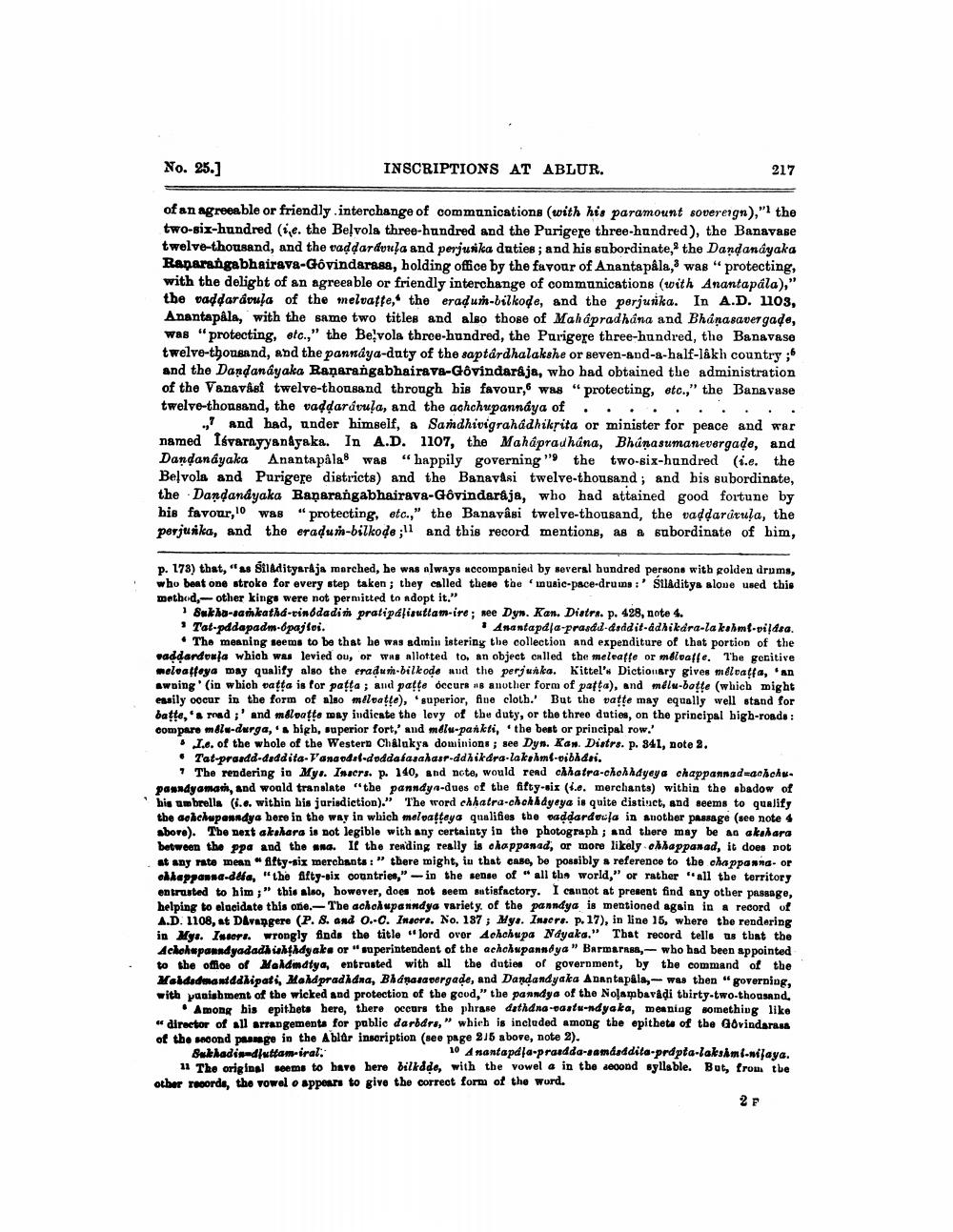________________
No. 25.]
INSCRIPTIONS AT ABLUR.
217
of an agreeable or friendly interchange of communications (with his paramount sovereign)," the two-Bir-hundred (e. the Beļvola three-hundred and the Purigere three-hundred), the Banavase twelve-thousand, and the vaddardyula and perjunka daties; and his subordinate, the Dandanayaka Ranarangabhairava-Govindarasa, holding office by the favour of Anantapala, was "protecting, with the delight of an agreeable or friendly interchange of communications (with Anantapála)," the vaddardvula of the melvate, the erad un-bilkode, and the perjurika. In A.D. 1103, Anantapala, with the same two titles and also those of Mahápradhana and Bhanasavergade, was "protecting, etc.," the Bevola three-hundred, the Purigere three-hundred, the Banavase twelve-thousand, and the panndya-duty of the saptárdhalakshe or seven-and-a-half-lakh country ;6 and the Dandanayaka Raņarangabhairava-Govindaraja, who had obtained the administration of the Vanavasi twelve-thousand through his favour, was "protecting, etc.," the Banavase twelve-thousand, the vaddarávula, and the achchupannaya of . . . . . . . . . .
And had, ander himself, a Sandhivigrahadhiksita or minister for peace and war named Isvarnyyanayaka. In A.D. 1107, the Mahápradhana, Bhúņasumanevergade, and Dandanayaka Anantapala was "happily governing " the two-six-hundred (i.e. the Beļvola and Purigere districts) and the Banavasi twelve-thousand ; and bis subordinate, the Dandandyaka Ranarangabhairava-Govindaraja, who had attained good fortune by his favour, was "protecting, etc.," the Banayâsi twelve-thousand, the vaddarúcula, the perjusika, and the eradurn-bilkode ;ll and this record mentions, as a subordinate of him,
p. 178) that, "as Siladityaraja marched, he was always accompanied by several hundred persons with golden drums, who beat one stroke for every step taken; they called these the music-pace-drums :' Siladitya alove used this method-other kings were not permitted to adopt it."
Sukho-sankathd-vinoda din pratipasisuttam-ire; nee Dyn. Kan. Diatra. p. 428, note 4. Tat-pddapadno-pajloi.
Anantapda-prasdd-dsddit-adhikdra-lakshmi-vildsa. • The meaning seems to be that he was admiu istering the collection and expenditure of that portion of the saddardoula which was levied ou, or was allotted to, an object called the meleaffe or méloaffe. The genitive meloatfoya may qualify also the eradum-bilkode and the perjunka. Kittel's Dictionary gives méltatta, an awning (in which vatra is for patta ; and patte occurs 18 another form of patta), and mélu-baffe (which might easily oocur in the form of also méloat!e), superior, fine cloth. But the patte may equally well stand for batte, rad,' and malpatto may indicate the levy of the duty, or the three duties, on the principal high-roads : compare m&lu-durga, 's bigb, Superior fort,' and mélu-pankti, the best or principal row.'
I... of the whole of the Western Chalukya dominions ; see Dyn. Kan. Distrs. p. 341, note 2. • Tat-praadd-daddita-'anaodsi-doddalasahasr.ddhikdra-lakshmi-vibadai.
* The rendering in Mys. Inscrs. p. 140, and ncte, would read chhatra-chodyeya chappannad-achchpaundyaman, and would translate "the panndya-dues of the fifty-six (1.e. merchants) within the sbadow of bis umbrella (ie. within his jurisdiction)." The word chhatra-chchhdyeya is quite distinct, and seems to qualify the achchupanndya here in the way in which melvatteya qualifies the paddardoula in another passage (see note 4 above). The next akahara is not legible with any certainty in the photograph; and there may be ao akahara between the ppa and the end. If the rending really is choppanad, or more likely chappanad, it does not at any rate mean "Atty-six merchants : " there might, in that case, be possibly s reference to the chappanna. or okkappanna-dla, "the Afty-six countries," - in the sense of all the world," or rather "all the territory entrasted to him;" this also, however, does not seem satisfactory. I cannot at present find any other passage, helping to elucidate this one.- Tbe acho upanndya variety of the panndya is mentioned again in a record of A.D. 1108, at Davangere (P. 8. and 0.-c. Insort. No. 187; Mys. Ingers. p. 17), in line 15, where the rendering in Mys. Incore. wrongly finds the title "lord over Achchupa Nayaka." That record tells us that the Achohupanndyadadh ishadyake or "superintendent of the achchupanndya" Barmarasa, who had been appointed to the office of Maldmatya, entrusted with all the duties of government, by the command of the Meldedmantadhipati, Mahápradhdna, Bhanasavergade, and Dandandyaka Anantapâle,-- was then "governing, with vanishment of the wicked and protection of the good," the panndya of the Nolambavadi thirty-two-thousand.
Among bis epithets here, there occurs the phrase dathdna-pastu-ndyaka, meaning somethivg like director of all arrangements for public darbdrs," which is included among the opithets of the Govindarasa of the second penge in the Ablar inscription (neo page 916 above, note 2). Sulhadiradluttamiral:
10 Anantapda-praadda-samdaddita-prdpta-lakshmi-wilaya. 11 The original seems to have here bilkdde, with the vowel a in the second syllable. But, from the other records, the vowel o appear to give the correct form of the word.
2 F




